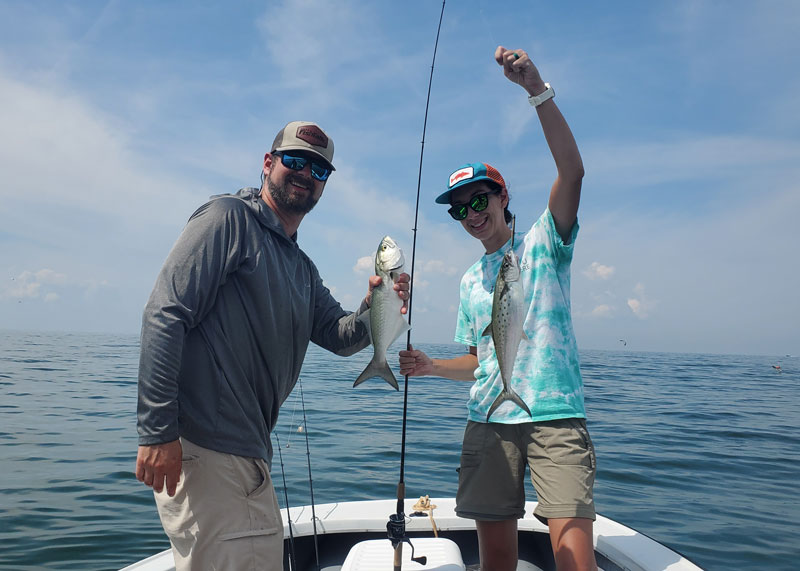We at FishTalk love getting a bit scientificalish now and again (see articles like Fishing Line Stretch Test: Stretching the Truth, and Fishing Hook Test: Fowl Play), especially when it uncovers some cool new factoids that help us catch more fish. And although it involves some (scary) math, engineering can be applied to fishing in the same way. One of the best examples of this we’ve ever seen came from the engineer-brain of this author, who found a formula for predicting the most effective Spanish mackerel trolling speed on any given day based on water temperatures (see Finding the Ideal Spanish Mackerel Trolling Speed). It works like a charm - and we generally now refer to him as "Mack Speed Walt." Now, he’s taken it yet another step into the mathematical abyss…

When Summer water temperatures in the Chesapeake Bay reach the low to mid-80s, that typically equates to the perfect time to chase Spanish mackerel. The ideal trolling speed when the water is 85 degrees is estimated at eight mph, as “Mack Speed” equals water temperature minus five divided by 10. In the case of 85-degree water, that’s (85 – 5) / 10 = 8 mph.
However, casting and retrieving for macks using light tackle is a blast! And we all hear time and time again, you just need to “crank as fast as you can.” Previous articles have concluded that cranking a spinning reel as fast as possible may still not approach Mack Speed. (See “Light Tackle Mackerel Fishing” on the website). But different reels crank at different speeds, which begs the question: how fast, exactly, do you have to crank a spinning reel to retrieve at Mack Speed?
Instead of measuring a portion of a mile, cranking away, and timing it, as a reliability/quality engineer I was thinking about speed and calculations again. Recently while fishing for stripers with a new Shimano Miravel MIR4000XG instead of my old reliable Pfueger President 6940X, I noticed that the retrieve felt faster. I had to slow down a little to catch stripers.
Sure enough, a quick check of the manufacturer specifications showed there was a significant difference in the inches per crank rating, 39 inches versus 30.2 inches. Hmmm, if I converted Mack Speed from MPH to inches per second, I could quickly determine how many cranks per second are needed to catch more mackerel. With a calculator in hand (and yes, I did make a spreadsheet), I found that to equal eight mph (or 141 inches per second) using my new Miravel, I need about three and a half cranks in a second. Using my older Pflueger President, however, attaining the same speed required closer to five cranks per second.
See the three simple steps in Table 1, to determine just how fast you need to crank your reel to tempt more mackerel into striking.
Table 1. How Fast Should You Crank?
|
Step 1 – Look up your reel retrieve rating. Step 2 – Determine the water temp. Step 3 – Read across to determine how many cranks per second are needed! |
Reel Retrieve Rating (Inches per Crank) |
||||||
|
39 |
37 |
36 |
30.2 |
29 |
|||
|
Water Temp (°F) |
Mack Speed (MPH) |
Mack Speed (Inches per second) * |
Cranks Per Second |
||||
|
75 |
7.0 |
123 |
3.2 |
3.3 |
3.4 |
4.1 |
4.2 |
|
80 |
7.5 |
132 |
3.4 |
3.6 |
3.7 |
4.4 |
4.6 |
|
85 |
8.0 |
141 |
3.6 |
3.8 |
3.9 |
4.7 |
4.9 |
*Retrieve rate assumes a full spool of line; remember that as spool diameter shrinks, each revolution brings in slightly less line.
Remember, don’t crank so fast you hurt your wrist, and slow down a bit when the lure gets close to the boat because you don’t want it to come flying out of the water at eight mph, or maybe more with some whiplash. And of course, keep your fingers clear of the mackerel’s mouth when you land them after cranking away.
Table 2. Some common spinning reels and their retrieve length per crank.
|
Brand |
Model |
Retrieve (in) |
|
Okuma |
ISX-40WOKM-0658 Inspira |
29 |
|
Penn |
Spinfisher 440SSG |
29 |
|
Pflueger |
President 6940X |
30.2 |
|
Shimano |
SEC3000HGFIC - SHM-3700 Sedona |
36 |
|
Shimano |
MIRC3000HG SHM-4628 Miravel |
36 |
|
Shimano |
STC3000XGFL SHM-3811 Stradic |
37 |
|
Shimano |
MIR4000XG SHM-4629 Miraval |
39 |
|
|
|
|
Finally, note that the 6.4 mph mentioned in “Light Tackle Mackerel Fishing” (as the fastest one was able to crank with one of those older spinning reels) is equal to a mere 113 inches per second — only fast enough for Mack Speed in 69-degree water, and I’m not sure there are many macks in water that cool in the first place.